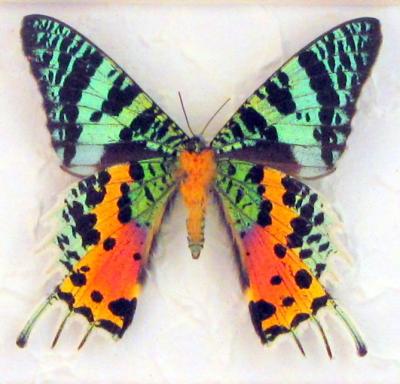Butterfly and Moth characteristics

Butterflies and moths all belong to the order Lepidoptera. Lepidoptera are then split into 34 superfamilies, each having specific characteristics. The majority of species in these families (95%) are nocturnal insects, and are commonly called moths.
Moths are generally characterized as being dull in color and nocturnal. However, there are very colorful day flying moths- pictured is the beautiful Sunset moth, Urania Ripheus, from Madagascar. Other day flying moths are part of the folowing families: Urania moths (Uraniidae ), Burnets ( Zygaenidae ) and Tiger moths ( Arctiidae ).
The majority of butterflies are colorful day fliers, yet there are tropical species that are drab in color and fly between dusk and dawn. i.e. Opsiphanes Owl butterflies and Melanitis Evening Browns.
Antennae are often said to be the distinguishing factor between moths and butterflies. Members of the butterfly families Papilionidae, Lycaenidae, Riodinidae, Nymphalidae and Pieridae do in fact have antennae with a pronounced club or swelling at the tip. However, just to trip you up, members of the moth families Zygaenidae and Castniidae also have a club or hooked tip. All other moth families have antennae that are tapered to a fine point, or have feathery plumes. Saturniidae males have feathery plumes that are used to detect and home in on female pheromones.
Simplified characteristics such as color, antennae and nocturnal habit can aid in identifying families of both butterflies and moths. These generalizations are taught to children and confuse us as we take that knowledge into adulthood and find exception to all the “rules” we learned as indentification. The true measure of determining the difference between moth and butterfly lies in the molecular analysis of the members belonging to the Lepidoptera order.